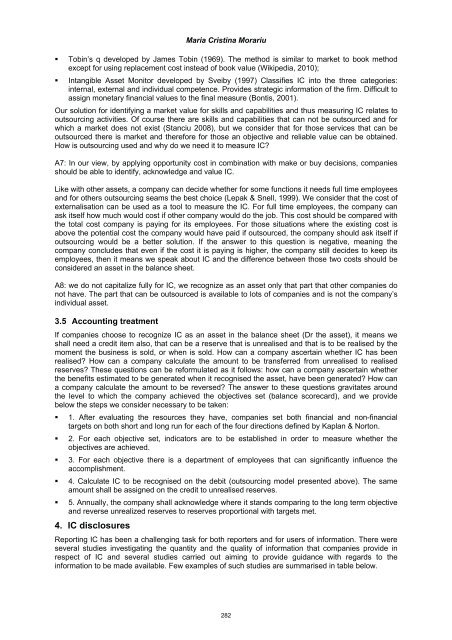Proceedings of the 3rd European Conference on Intellectual Capital
Proceedings of the 3rd European Conference on Intellectual Capital
Proceedings of the 3rd European Conference on Intellectual Capital
You also want an ePaper? Increase the reach of your titles
YUMPU automatically turns print PDFs into web optimized ePapers that Google loves.
Maria Cristina Morariu<br />
Tobin’s q developed by James Tobin (1969). The method is similar to market to book method<br />
except for using replacement cost instead <str<strong>on</strong>g>of</str<strong>on</strong>g> book value (Wikipedia, 2010);<br />
Intangible Asset M<strong>on</strong>itor developed by Sveiby (1997) Classifies IC into <str<strong>on</strong>g>the</str<strong>on</strong>g> three categories:<br />
internal, external and individual competence. Provides strategic informati<strong>on</strong> <str<strong>on</strong>g>of</str<strong>on</strong>g> <str<strong>on</strong>g>the</str<strong>on</strong>g> firm. Difficult to<br />
assign m<strong>on</strong>etary financial values to <str<strong>on</strong>g>the</str<strong>on</strong>g> final measure (B<strong>on</strong>tis, 2001).<br />
Our soluti<strong>on</strong> for identifying a market value for skills and capabilities and thus measuring IC relates to<br />
outsourcing activities. Of course <str<strong>on</strong>g>the</str<strong>on</strong>g>re are skills and capabilities that can not be outsourced and for<br />
which a market does not exist (Stanciu 2008), but we c<strong>on</strong>sider that for those services that can be<br />
outsourced <str<strong>on</strong>g>the</str<strong>on</strong>g>re is market and <str<strong>on</strong>g>the</str<strong>on</strong>g>refore for those an objective and reliable value can be obtained.<br />
How is outsourcing used and why do we need it to measure IC?<br />
A7: In our view, by applying opportunity cost in combinati<strong>on</strong> with make or buy decisi<strong>on</strong>s, companies<br />
should be able to identify, acknowledge and value IC.<br />
Like with o<str<strong>on</strong>g>the</str<strong>on</strong>g>r assets, a company can decide whe<str<strong>on</strong>g>the</str<strong>on</strong>g>r for some functi<strong>on</strong>s it needs full time employees<br />
and for o<str<strong>on</strong>g>the</str<strong>on</strong>g>rs outsourcing seams <str<strong>on</strong>g>the</str<strong>on</strong>g> best choice (Lepak & Snell, 1999). We c<strong>on</strong>sider that <str<strong>on</strong>g>the</str<strong>on</strong>g> cost <str<strong>on</strong>g>of</str<strong>on</strong>g><br />
externalisati<strong>on</strong> can be used as a tool to measure <str<strong>on</strong>g>the</str<strong>on</strong>g> IC. For full time employees, <str<strong>on</strong>g>the</str<strong>on</strong>g> company can<br />
ask itself how much would cost if o<str<strong>on</strong>g>the</str<strong>on</strong>g>r company would do <str<strong>on</strong>g>the</str<strong>on</strong>g> job. This cost should be compared with<br />
<str<strong>on</strong>g>the</str<strong>on</strong>g> total cost company is paying for its employees. For those situati<strong>on</strong>s where <str<strong>on</strong>g>the</str<strong>on</strong>g> existing cost is<br />
above <str<strong>on</strong>g>the</str<strong>on</strong>g> potential cost <str<strong>on</strong>g>the</str<strong>on</strong>g> company would have paid if outsourced, <str<strong>on</strong>g>the</str<strong>on</strong>g> company should ask itself if<br />
outsourcing would be a better soluti<strong>on</strong>. If <str<strong>on</strong>g>the</str<strong>on</strong>g> answer to this questi<strong>on</strong> is negative, meaning <str<strong>on</strong>g>the</str<strong>on</strong>g><br />
company c<strong>on</strong>cludes that even if <str<strong>on</strong>g>the</str<strong>on</strong>g> cost it is paying is higher, <str<strong>on</strong>g>the</str<strong>on</strong>g> company still decides to keep its<br />
employees, <str<strong>on</strong>g>the</str<strong>on</strong>g>n it means we speak about IC and <str<strong>on</strong>g>the</str<strong>on</strong>g> difference between those two costs should be<br />
c<strong>on</strong>sidered an asset in <str<strong>on</strong>g>the</str<strong>on</strong>g> balance sheet.<br />
A8: we do not capitalize fully for IC, we recognize as an asset <strong>on</strong>ly that part that o<str<strong>on</strong>g>the</str<strong>on</strong>g>r companies do<br />
not have. The part that can be outsourced is available to lots <str<strong>on</strong>g>of</str<strong>on</strong>g> companies and is not <str<strong>on</strong>g>the</str<strong>on</strong>g> company’s<br />
individual asset.<br />
3.5 Accounting treatment<br />
If companies choose to recognize IC as an asset in <str<strong>on</strong>g>the</str<strong>on</strong>g> balance sheet (Dr <str<strong>on</strong>g>the</str<strong>on</strong>g> asset), it means we<br />
shall need a credit item also, that can be a reserve that is unrealised and that is to be realised by <str<strong>on</strong>g>the</str<strong>on</strong>g><br />
moment <str<strong>on</strong>g>the</str<strong>on</strong>g> business is sold, or when is sold. How can a company ascertain whe<str<strong>on</strong>g>the</str<strong>on</strong>g>r IC has been<br />
realised? How can a company calculate <str<strong>on</strong>g>the</str<strong>on</strong>g> amount to be transferred from unrealised to realised<br />
reserves? These questi<strong>on</strong>s can be reformulated as it follows: how can a company ascertain whe<str<strong>on</strong>g>the</str<strong>on</strong>g>r<br />
<str<strong>on</strong>g>the</str<strong>on</strong>g> benefits estimated to be generated when it recognised <str<strong>on</strong>g>the</str<strong>on</strong>g> asset, have been generated? How can<br />
a company calculate <str<strong>on</strong>g>the</str<strong>on</strong>g> amount to be reversed? The answer to <str<strong>on</strong>g>the</str<strong>on</strong>g>se questi<strong>on</strong>s gravitates around<br />
<str<strong>on</strong>g>the</str<strong>on</strong>g> level to which <str<strong>on</strong>g>the</str<strong>on</strong>g> company achieved <str<strong>on</strong>g>the</str<strong>on</strong>g> objectives set (balance scorecard), and we provide<br />
below <str<strong>on</strong>g>the</str<strong>on</strong>g> steps we c<strong>on</strong>sider necessary to be taken:<br />
1. After evaluating <str<strong>on</strong>g>the</str<strong>on</strong>g> resources <str<strong>on</strong>g>the</str<strong>on</strong>g>y have, companies set both financial and n<strong>on</strong>-financial<br />
targets <strong>on</strong> both short and l<strong>on</strong>g run for each <str<strong>on</strong>g>of</str<strong>on</strong>g> <str<strong>on</strong>g>the</str<strong>on</strong>g> four directi<strong>on</strong>s defined by Kaplan & Nort<strong>on</strong>.<br />
2. For each objective set, indicators are to be established in order to measure whe<str<strong>on</strong>g>the</str<strong>on</strong>g>r <str<strong>on</strong>g>the</str<strong>on</strong>g><br />
objectives are achieved.<br />
3. For each objective <str<strong>on</strong>g>the</str<strong>on</strong>g>re is a department <str<strong>on</strong>g>of</str<strong>on</strong>g> employees that can significantly influence <str<strong>on</strong>g>the</str<strong>on</strong>g><br />
accomplishment.<br />
4. Calculate IC to be recognised <strong>on</strong> <str<strong>on</strong>g>the</str<strong>on</strong>g> debit (outsourcing model presented above). The same<br />
amount shall be assigned <strong>on</strong> <str<strong>on</strong>g>the</str<strong>on</strong>g> credit to unrealised reserves.<br />
5. Annually, <str<strong>on</strong>g>the</str<strong>on</strong>g> company shall acknowledge where it stands comparing to <str<strong>on</strong>g>the</str<strong>on</strong>g> l<strong>on</strong>g term objective<br />
and reverse unrealized reserves to reserves proporti<strong>on</strong>al with targets met.<br />
4. IC disclosures<br />
Reporting IC has been a challenging task for both reporters and for users <str<strong>on</strong>g>of</str<strong>on</strong>g> informati<strong>on</strong>. There were<br />
several studies investigating <str<strong>on</strong>g>the</str<strong>on</strong>g> quantity and <str<strong>on</strong>g>the</str<strong>on</strong>g> quality <str<strong>on</strong>g>of</str<strong>on</strong>g> informati<strong>on</strong> that companies provide in<br />
respect <str<strong>on</strong>g>of</str<strong>on</strong>g> IC and several studies carried out aiming to provide guidance with regards to <str<strong>on</strong>g>the</str<strong>on</strong>g><br />
informati<strong>on</strong> to be made available. Few examples <str<strong>on</strong>g>of</str<strong>on</strong>g> such studies are summarised in table below.<br />
282
















